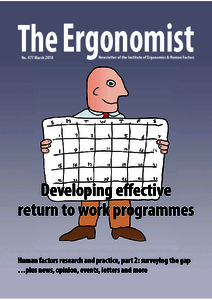Work should no longer be seen as toxic; it is in fact generally good for our health and wellbeing. There is a caveat of course: the benefit seemingly applies to ‘good’ jobs in a modern world. The characteristics defining a good job relate more to the context of the job than the content, incorporating such things as pay and conditions, satisfaction and fulfilment. Safety at work is a crucial consideration, but the underlying risk management model, whilst very
effective when there is a clear exposure-response relationship, has not been helpful for preventing or controlling common musculoskeletal problems. During the very period when work has become physically less demanding and risk management regulations have become more pervasive, the incidence and prevalence of musculoskeletal symptoms have not reduced whilst their disabling
consequences have actually increased.
Downloads
Downloads per month over past year
Downloads per month over past year for
"Burton477_March_p1213.pdf"
Downloads per month over past year for
"burton-ergonomist-flags-2010cover.jpg"

![burton-ergonomist-flags-2010cover.jpg [thumbnail of burton-ergonomist-flags-2010cover.jpg]](https://eprints.hud.ac.uk/9602/7.hassmallThumbnailVersion/burton-ergonomist-flags-2010cover.jpg)

 CORE (COnnecting REpositories)
CORE (COnnecting REpositories) CORE (COnnecting REpositories)
CORE (COnnecting REpositories)